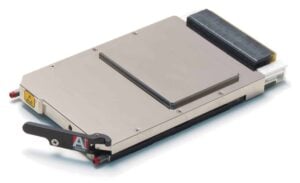 Aitech Systems’ C530 GPGPU (General-Purpose Graphics Processing Unit) 3U VPX board is now offered with GPUs based on NVIDIA’s Turing architecture. The high-performance board provides accelerated data processing of multiple streams simultaneously for artificial intelligence applications. Based on COTS open-standard architectures, the rugged solution is easily integrated into platforms such as UAVs (unmanned aerial vehicles) and UGVs (unmanned ground vehicles).
Aitech Systems’ C530 GPGPU (General-Purpose Graphics Processing Unit) 3U VPX board is now offered with GPUs based on NVIDIA’s Turing architecture. The high-performance board provides accelerated data processing of multiple streams simultaneously for artificial intelligence applications. Based on COTS open-standard architectures, the rugged solution is easily integrated into platforms such as UAVs (unmanned aerial vehicles) and UGVs (unmanned ground vehicles).
The C530 currently supports the 80W NVIDIA RTX 3000 GPU and the 50W NVIDIA T1000 GPU, with new configurations released as higher-performance MXMs become available. It operates as a peripheral board with a compatible x86 VPX host SBC (single board computer), connected to the host SBC over the VPX backplane, via a high speed PCIe Gen3 link of up to 16 lanes. Four independent HDMI video ports each support resolutions of up to 1600×1200 at 60 Hz.
The use of multi-layered artificial neural networks and the NVIDIA Turing architecture-based GPUs’ ability to concurrently execute floating point and integer operations give the board a distinct performance advantage over non-GPGPU accelerated architectures. When equipped with the NVIDIA RTX 3000 GPU, the C530 houses 1920 CUDA cores for parallel processing, 240 Tensor Cores for AI inference, 30 RT Ray-Tracing Cores for real-time rendering and 6 GB DDR6 for processing of up to 5.3 TFLOPS (FP32). The T1000 GPU’s 896 CUDA cores and 4 GB DDR5 enable 2.6 TFLOPS (FP32) of data processing.
The C530 is ideal for complex high-accuracy tasks such as object detection, classification, segmentation and motion detection, and is currently utilized widely for rugged HPEC (high performance embedded computing) applications such as surveillance, targeting, advanced weapons systems, avionics and industrial environments.
Dan Mor, GPGPU product line manager for Aitech, commented: “There’s a growing need for more advanced platforms that enable higher computation power and relatively low power consumption, while handling many independent video outputs and providing a large throughput back out to the network. Our enhanced C530 uses the power of NVIDIA to provide these performance needs for compute-intensive applications like AI delivery, video analytics and image processing.”


















